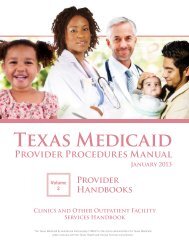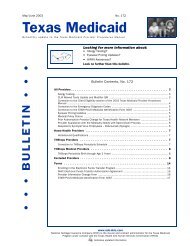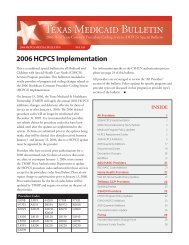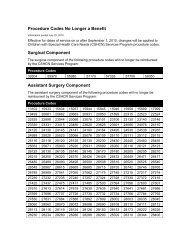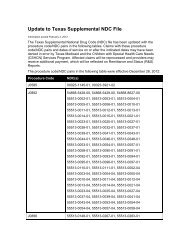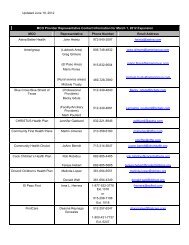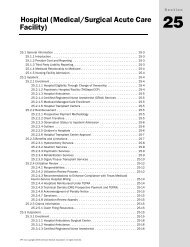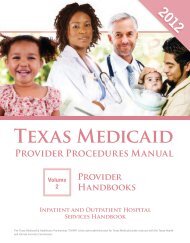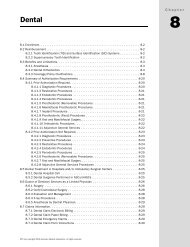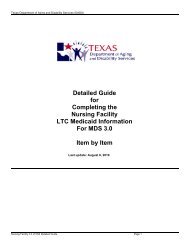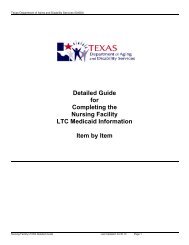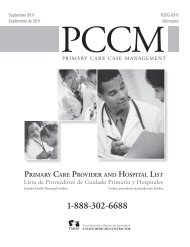Pediatric Hospital Bed and Crib Benefits to Change for CCP ... - TMHP
Pediatric Hospital Bed and Crib Benefits to Change for CCP ... - TMHP
Pediatric Hospital Bed and Crib Benefits to Change for CCP ... - TMHP
You also want an ePaper? Increase the reach of your titles
YUMPU automatically turns print PDFs into web optimized ePapers that Google loves.
<strong>Pediatric</strong> <strong>Hospital</strong> <strong>Bed</strong> <strong>and</strong> <strong>Crib</strong> <strong>Benefits</strong> <strong>to</strong> <strong>Change</strong> <strong>for</strong><br />
<strong>CCP</strong> Effective March 1, 2013<br />
In<strong>for</strong>mation posted January 11, 2013<br />
Effective <strong>for</strong> dates of service on or after March 1, 2013, benefit criteria <strong>for</strong> pediatric<br />
hospital beds <strong>and</strong> cribs will change <strong>for</strong> the Comprehensive Care Program (<strong>CCP</strong>).<br />
A pediatric hospital bed or pediatric crib is defined as a bed with all of the following<br />
features:<br />
A bed that allows adjustment of the head <strong>and</strong> foot of the bed.<br />
o A manual pediatric hospital bed (procedure code E0328) or pediatric crib<br />
(procedure code E0300) allows manual adjustment <strong>to</strong> the head <strong>and</strong> leg elevation.<br />
o A semi-electric or fully electric hospital bed (procedure code E0329) allows<br />
manual or electric adjustments <strong>to</strong> height <strong>and</strong> electric adjustments <strong>to</strong> head <strong>and</strong> leg<br />
elevation.<br />
A headboard<br />
A footboard<br />
A mattress<br />
Side rails of any type (A side rail is defined as a hinged or removable rail, board, or<br />
panel.)<br />
<strong>Pediatric</strong> hospital beds or pediatric cribs that do not have all of these features will not be<br />
considered <strong>for</strong> prior authorization.<br />
A bed that has side rails that extend 24 inches or less above the mattress is considered<br />
a pediatric hospital bed (procedure code E0328 or E0329.) A pediatric hospital bed may<br />
be fixed or variable height. Variable height beds may be adjusted manually or powered,<br />
as required <strong>for</strong> the client’s medical condition.<br />
Procedure codes E0328 <strong>and</strong> E0329 will be restricted <strong>to</strong> clients who are 20 years of age<br />
<strong>and</strong> younger.<br />
A bed that has side rails that extend more than 24 inches above the mattress is<br />
considered a pediatric crib (procedure code E0300).<br />
A pediatric hospital bed or pediatric crib of any width that has all of the features defined<br />
above will only be considered <strong>for</strong> prior authorization under procedure code E0300,<br />
E0328, or E0329. Procedure code E0316 may be used in conjunction with procedure<br />
code E0300, E0328, or E0329 <strong>to</strong> request a pediatric fully-enclosed bed with a canopy.<br />
Procedure code E1399 will only be used <strong>for</strong> reflux swings.<br />
<strong>Hospital</strong> beds that are not fully enclosed can be considered through Texas Medicaid<br />
home health services.<br />
Note: Texas Medicaid defines fully enclosed as having 360-degree side enclosures.
Documentation Requirements<br />
All pediatric hospital bed <strong>and</strong> pediatric crib procedure codes may be considered <strong>for</strong> prior<br />
authorization when the documentation submitted clearly shows that the requested bed or<br />
crib will correct or ameliorate the client’s condition. Documentation must include at least<br />
one of the following criteria:<br />
The client’s medical condition requires positioning of the body in ways that are not<br />
feasible in an ordinary bed, including, but not limited <strong>to</strong>, positioning needs <strong>to</strong> alleviate<br />
pain.<br />
The head of the bed must be elevated 30 or more degrees most of the time due <strong>to</strong>,<br />
but not limited <strong>to</strong>, congestive heart failure, chronic pulmonary disease, or problems<br />
with aspiration, <strong>and</strong> alternative measures, such as wedges or pillows, have been<br />
attempted but have failed <strong>to</strong> manage the client’s medical condition.<br />
Note: Texas Medicaid defines a failed measure as having no clinically significant<br />
improvement after being introduced.<br />
The client requires traction equipment that can be attached only <strong>to</strong> a hospital bed.<br />
A semi-electric or fully electric hospital bed (procedure code E0329) may be considered<br />
<strong>for</strong> prior authorization when the submitted documentation shows that the client has a<br />
medical condition that requires frequent changes in body position or might require an<br />
immediate change in body position <strong>to</strong> avert a life-threatening situation.<br />
For more in<strong>for</strong>mation, call the <strong>TMHP</strong> Contact Center at 1-800-925-9126.



